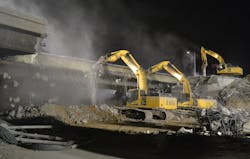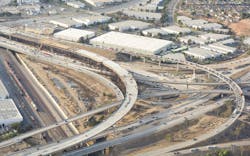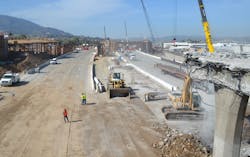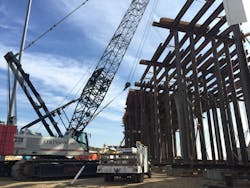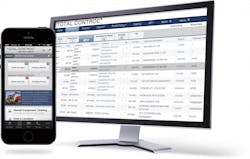Telematics Contribute to Project Success
In early 2014, the joint-venture partnership of Atkinson Construction (headquartered in Golden, Colo.) and Walsh Construction (based in Chicago) was awarded a $632 million design-build contract for the road and bridge work included in California’s $1.4 billion SR-91 project. The project was aimed at relieving ever-increasing traffic congestion along one of the state’s busiest corridors, State Route 91, between Anaheim and Corona.
The contract required completion of major highway and bridge work by early 2017, with all ancillary work completed by the end of 2017. The joint venture met the deadlines, but needed ample equipment and manpower to do so.
“As it turned out,” says Tim Karle, Atkinson’s equipment superintendent, who also managed the joint-venture fleet, “we had nearly 400 pieces of owned equipment on site and probably 200 rental pieces. During peak times, more than 750 craft employees were on the project, which was a 24/7 operation for the better part of 2-1/2 years.
“We decided early on that the only chance we had of managing a fleet of this size, spread over probably 10 miles on the project, was to have a telematics system on virtually all motorized equipment. That enabled us to track location and was a means for keeping everything practically utilized and maintained on schedule. I’d estimate that we had 98 percent of the project’s equipment connected with telematics.”
Project scope
Challenged by these daunting numbers, the RCTC partnered with Caltrans, the city of Corona, the Orange County Transportation Authority, and the Federal Highway Administration to develop a plan for creating a more efficient SR-91 corridor, which, by some estimates, could save motorists using the new express toll lanes as much as 90 minutes on a round-trip commute during peak hours.
According to the RCTC’s Public Affairs Office, major construction in the SR-91 improvement plan involved extending the existing Orange County express lanes eight miles east to Interstate 15—two lanes in each direction, as well as adding a general-purpose lane in each direction along most of that corridor. The I-15/SR-91 interchange was substantially modified, and a two-mile tolled express lane was added in each direction on I-15 south of the interchange. In total, road construction involved an estimated 48 lane-miles.
The second major aspect of the joint venture’s contract was bridge work, says Karle. In all, 32 bridges were involved, “some requiring widening, some complete teardown and rebuild, and some were newly constructed,” he says. In addition, the contract called for 100 retaining walls, totaling nearly 1 million square feet, and nearly 300,000 square feet of sound walls.
The joint venture retained URS Corp. (now AECOM)as the project’s designer, and according to the RCTC, the design-build approach trimmed three years from the project’s schedule, compared with a conventional design-bid-build approach. The joint venture was selected from a field of four design-build firms that were prequalified to submit proposals, and according to the RCTC, the Atkinson/Walsh joint venture was selected “based on its innovative proposal and competitive price.”
Among the joint venture’s “alternate technical concepts” was a plan for project staging and traffic control that eliminated the need for temporary roadway widening, as well as a design that simplified connecting SR-91 express lanes with I-15 south, resulting in reducing the size of the bridge required by some 200,000 square feet, as well as reducing the number of straddle bents over SR-91 from nine to two. (Straddle bents are pier structures that span—straddle—a roadway; used when a conventional pier would require placement in the middle of the roadway.)
Coordinating telematics
“We worked with our rental companies to ensure that any piece of equipment that could use telematics was so equipped for use on the SR-91 project,” says Karle. “United Rentals became our primary supplier for the project, and we could access telematics data from those units with the company’s Total Control system.”
According to Mark Volkoff, Los Angeles district manager for United Rentals, the company routinely installs a telematics system on every piece of equipment in its fleet that has sufficient battery power to accommodate the technology. The company typically uses telematics systems from ZTR Control Systems, he says, a company that provides a selection of telematics hardware.
Among the new equipment purchased by the joint venture for the project were 250 Ford trucks—ranging from F150 pickups to F650 models used for attenuator vehicles—that were factory equipped with telematics, the Ford Crew Chief system, which is powered by Telogis.
In addition, the joint venture purchased in excess of 60 new pieces, including light plants, air compressors, and telehandlers, all of which Atkinson fitted with Telogis systems. Major pieces of on-site equipment owned by the joint-venture companies were either Caterpillar or John Deere, says Karle, with proprietary telematics systems accessed via VisionLink or JDLink, respectively.
“Using the AEMP/ISO feed,” says Karle, “we were able to place all the owned joint-venture equipment and vehicles on one screen, whether Caterpillar, Deere, or those with Telogis systems. All the United Rentals pieces were accessed via the company’s Total Control system on a separate screen. Equipment rented from the local Caterpillar dealer could be tracked through VisionLink.”
System benefits
“At peak times,” says Karle, “45 or more rented telehandlers were on the project. Just making sure all these machines were being used was a big task. Using the Total Control system, we were able to see, for instance, where we were on the monthly rental for these pieces. That capability, alone, saved a huge amount of money by helping us avoid keeping the machine into the next rental period if it wasn’t needed.”
To assist the joint venture with managing rented equipment, a United Rentals representative was on site Monday through Friday to help with logistics such as transport and routine service. The company also provided an on-site mechanic and had two trucks available for moving equipment around the project.
“Having a second set of eyes watching the rental-equipment screen was valuable,” says Karle.
“On a project of this size,” says United Rentals’ Volkoff, “the landscape is continually changing, and it can be difficult to locate small equipment if known landmarks are no longer there. But with telematics, if a driver had to pick up a unit at a particular location, or if a technician needed to service the unit, they could pull the location up on their phone and visibly see the machine’s location.”
In terms of utilization efficiency, says Volkoff, United Rentals’ Total Control system allowed utilization thresholds to be set for individual units, such as light towers.
“If we determined that a particular unit had not been turned on in, say, 48 hours, then we could contact the supervisor of that site to determine the reason. If the unit was no longer needed at that site, it could be moved to where it would be used, instead of renting yet another light tower. This eliminated a tremendous amount of waste that would have been difficult to uncover without telematics.”
A weekly utilization report for all equipment on the project, says Karle, allowed managers to compare usage rates for owned equipment versus rented equipment. “If we identified rental pieces that were getting more hours than owned equipment,” he says, “we could make a switch and save the rental.”
The weekly report generated from telematics data also provided Karle and the joint-venture’s equipment-management staff information regarding hours of operation, fuel burn, and idling time—the latter, says Karle, used to encourage site supervisors to pay attention to machines left idling unnecessarily. This information also was the basis for a rigid preventive-maintenance program.
“We ran a weekly PM report that went to the oilers,” says Karle, “so they knew in detail what had to be done for the week—they didn’t have to run around the project collecting hour-meter readings off every piece
of equipment.”
The joint-venture’s maintenance crew and United Rentals’ mechanics basically looked after all the off-road equipment, and a program set up with the local truck dealer handled PM for on-road vehicles. For both, however, the maintenance system was set up to report critical fault codes generated by the telematics systems, allowing the maintenance crew to immediately address these issues.
Below: United Rentals’ Total Control system provided project managers a complete inventory of all equipment on the project.
An unused building on the site was turned into a maintenance facility at minimal cost, says Karle, and was staffed by Atkinson technicians and apprentices from the Operating Engineers Local 12’s hall. A number of service trucks were those from the joint-venture companies, others were purchased new for the project. Any temporary needs for additional service trucks were filled with vehicles from Atkinson’s nearby maintenance facility and rented to the project.
Another aspect of telematics on the project was that of theft deterrence. “On a project of this size, says United Rentals’ Volkoff, “you’re going to have some pieces disappear, usually items that can be quickly loaded into a pickup or can be towed. The Total Control system allows us to set up geo-fences if the customer chooses, and the loss of equipment on this project was substantially less than you’d think.”
Karle concurs about the usefulness of telematics systems to mitigate theft. “Our experience is that probably 15 pieces will go missing in year, but we typically recover all but one or two. We stay on top of that. We also have a good relationship with the Corona Police Department—that helps when issues arise; the department’s willingness to set up extra patrols during the project was an asset.”
